Analyzing Symptom Clusters: A Case Study in Mental Health Nursing
VerifiedAdded on 2023/04/25
|17
|1271
|494
Case Study
AI Summary
This case study presentation analyzes Ms. Megan's case, a 36-year-old woman experiencing depression following the loss of her son. It identifies her symptom cluster, including neglect, insomnia, and suicidal thoughts, and proposes using the WA Chronic Health Conditions Framework for care delivery. The analysis explores the etiology of her depression, suggests diagnostic tools like the CES-DR and HADS, and outlines preventive and management strategies such as psychotherapy and medication. The overall goal is effective collaboration to improve Ms. Megan's mental health and quality of life. The presentation also discusses potential barriers and facilitators in implementing the framework and highlights the role of a registered nurse in achieving optimal outcomes.

Symptom Cluster
A CASE STUDY
A CASE STUDY
Paraphrase This Document
Need a fresh take? Get an instant paraphrase of this document with our AI Paraphraser
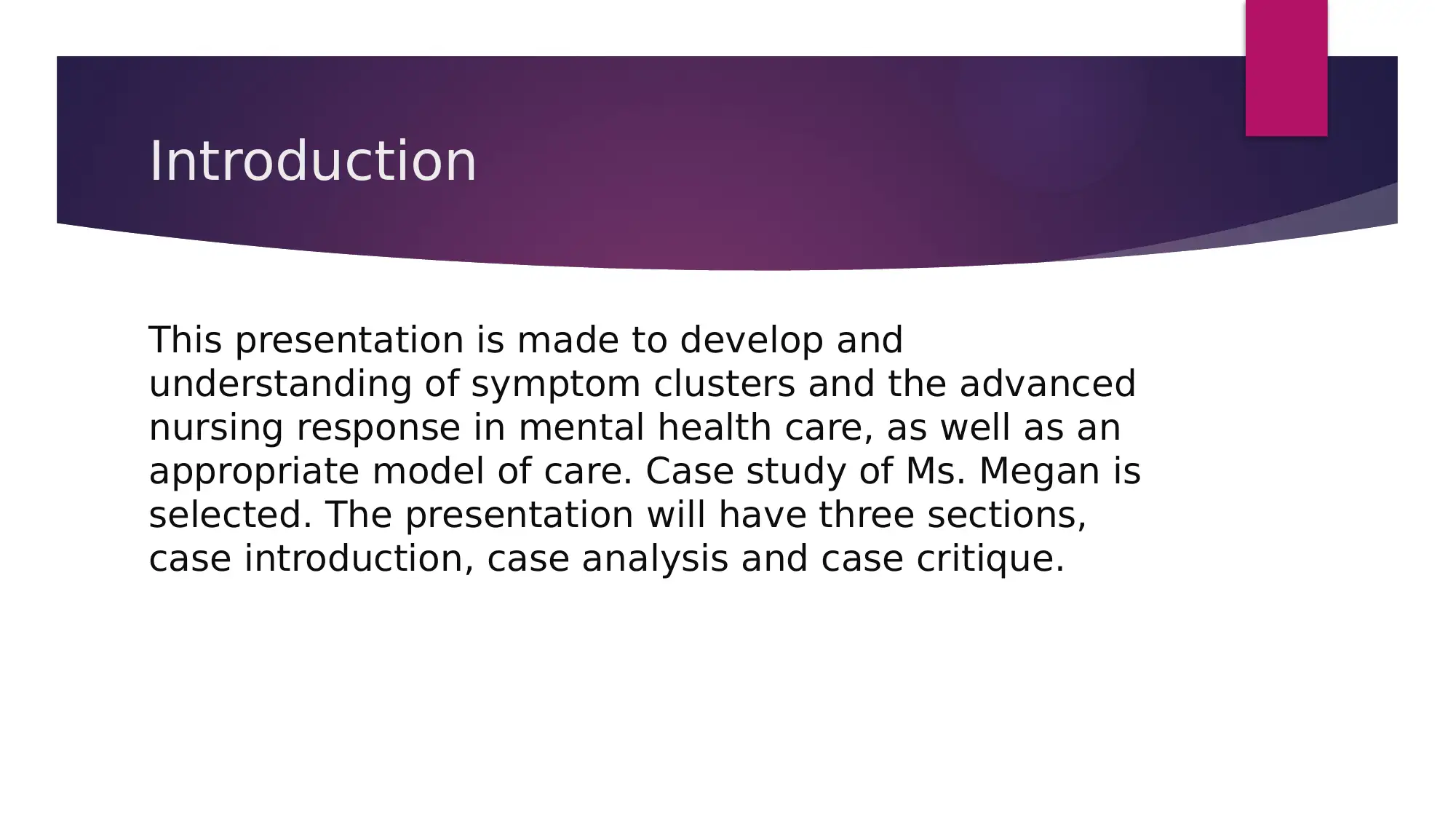
Introduction
This presentation is made to develop and
understanding of symptom clusters and the advanced
nursing response in mental health care, as well as an
appropriate model of care. Case study of Ms. Megan is
selected. The presentation will have three sections,
case introduction, case analysis and case critique.
This presentation is made to develop and
understanding of symptom clusters and the advanced
nursing response in mental health care, as well as an
appropriate model of care. Case study of Ms. Megan is
selected. The presentation will have three sections,
case introduction, case analysis and case critique.

Case Study Introduction
⊘ This is a preview!⊘
Do you want full access?
Subscribe today to unlock all pages.

Trusted by 1+ million students worldwide
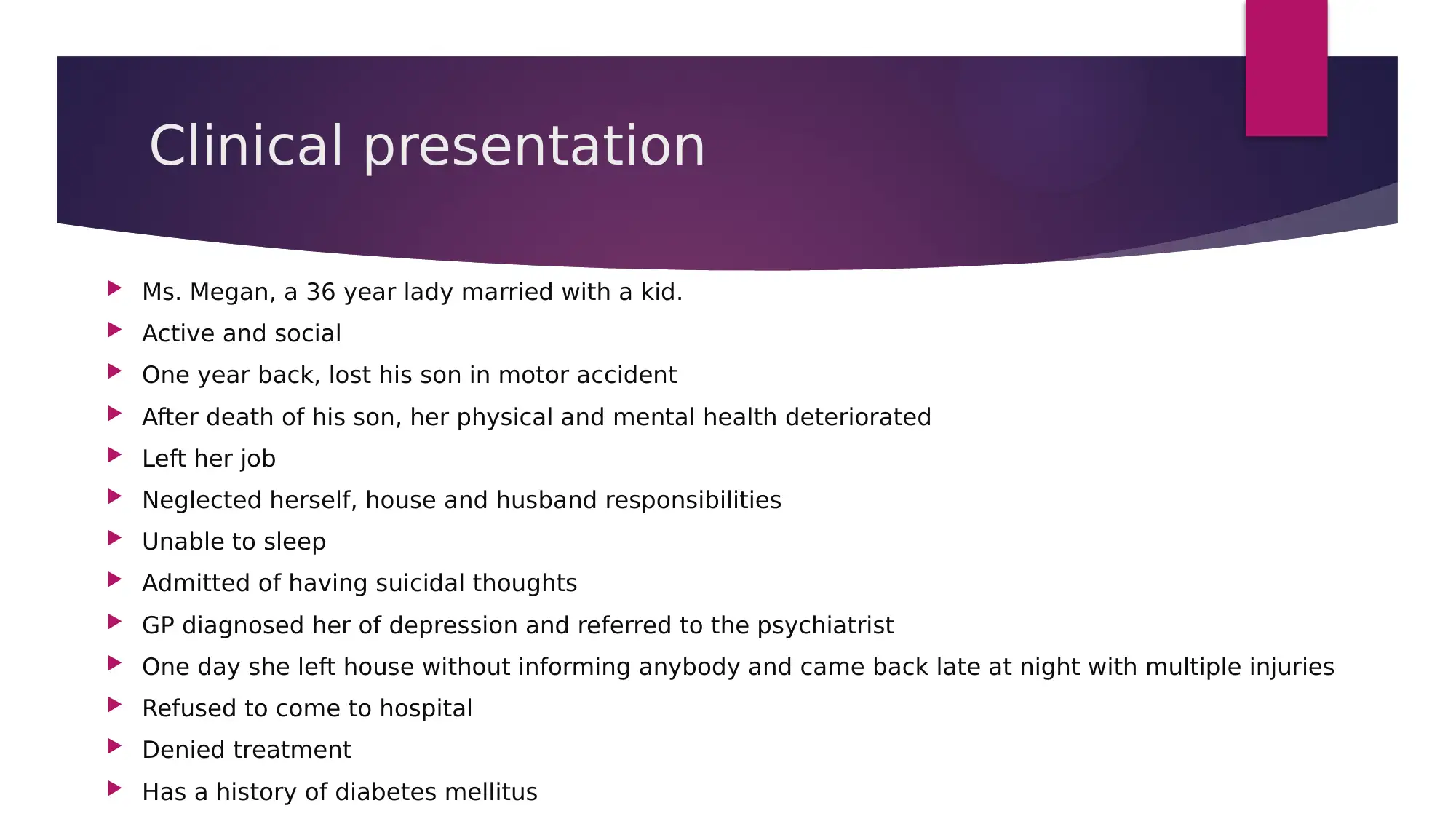
Clinical presentation
Ms. Megan, a 36 year lady married with a kid.
Active and social
One year back, lost his son in motor accident
After death of his son, her physical and mental health deteriorated
Left her job
Neglected herself, house and husband responsibilities
Unable to sleep
Admitted of having suicidal thoughts
GP diagnosed her of depression and referred to the psychiatrist
One day she left house without informing anybody and came back late at night with multiple injuries
Refused to come to hospital
Denied treatment
Has a history of diabetes mellitus
Ms. Megan, a 36 year lady married with a kid.
Active and social
One year back, lost his son in motor accident
After death of his son, her physical and mental health deteriorated
Left her job
Neglected herself, house and husband responsibilities
Unable to sleep
Admitted of having suicidal thoughts
GP diagnosed her of depression and referred to the psychiatrist
One day she left house without informing anybody and came back late at night with multiple injuries
Refused to come to hospital
Denied treatment
Has a history of diabetes mellitus
Paraphrase This Document
Need a fresh take? Get an instant paraphrase of this document with our AI Paraphraser
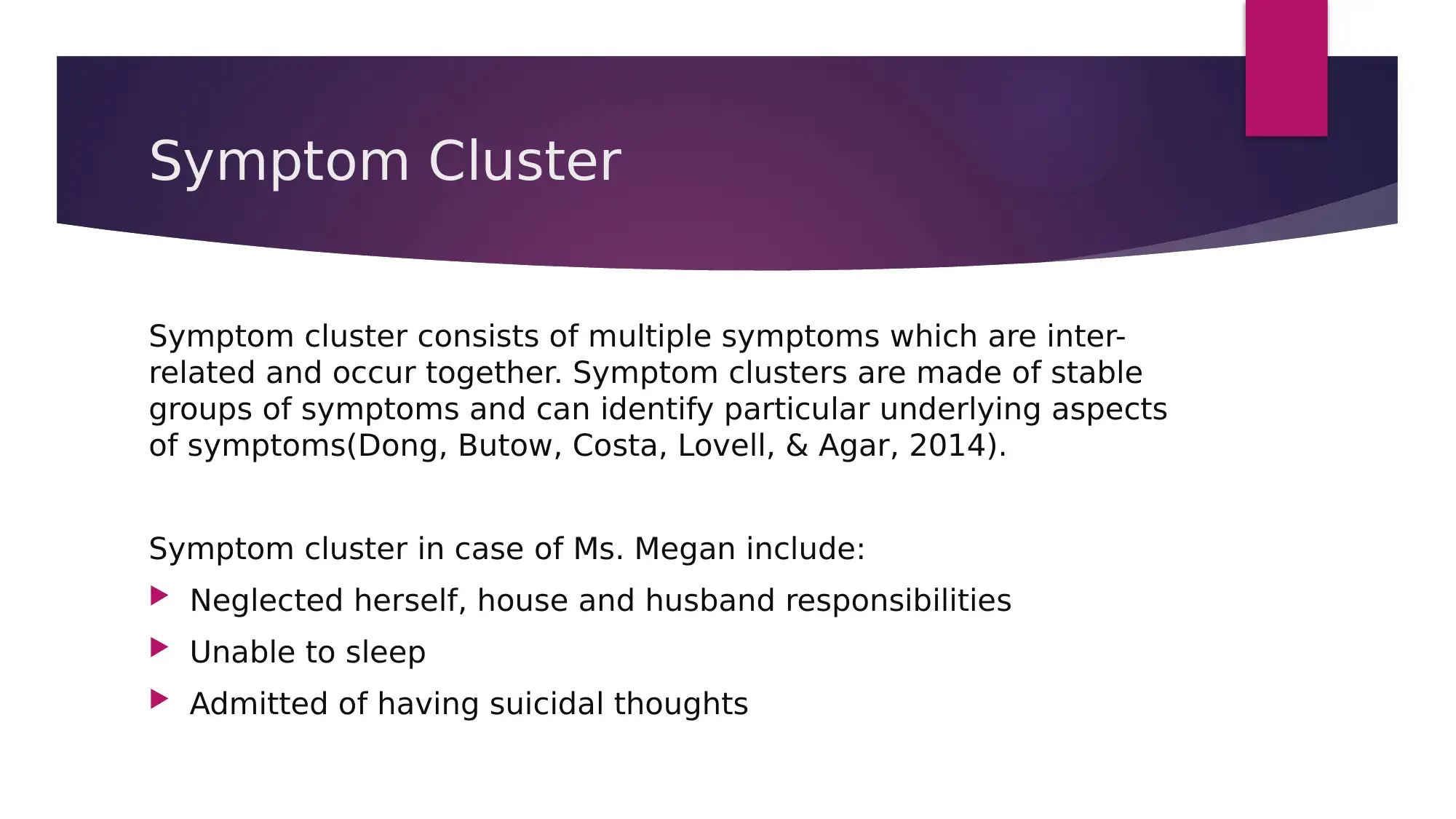
Symptom Cluster
Symptom cluster consists of multiple symptoms which are inter-
related and occur together. Symptom clusters are made of stable
groups of symptoms and can identify particular underlying aspects
of symptoms(Dong, Butow, Costa, Lovell, & Agar, 2014).
Symptom cluster in case of Ms. Megan include:
Neglected herself, house and husband responsibilities
Unable to sleep
Admitted of having suicidal thoughts
Symptom cluster consists of multiple symptoms which are inter-
related and occur together. Symptom clusters are made of stable
groups of symptoms and can identify particular underlying aspects
of symptoms(Dong, Butow, Costa, Lovell, & Agar, 2014).
Symptom cluster in case of Ms. Megan include:
Neglected herself, house and husband responsibilities
Unable to sleep
Admitted of having suicidal thoughts
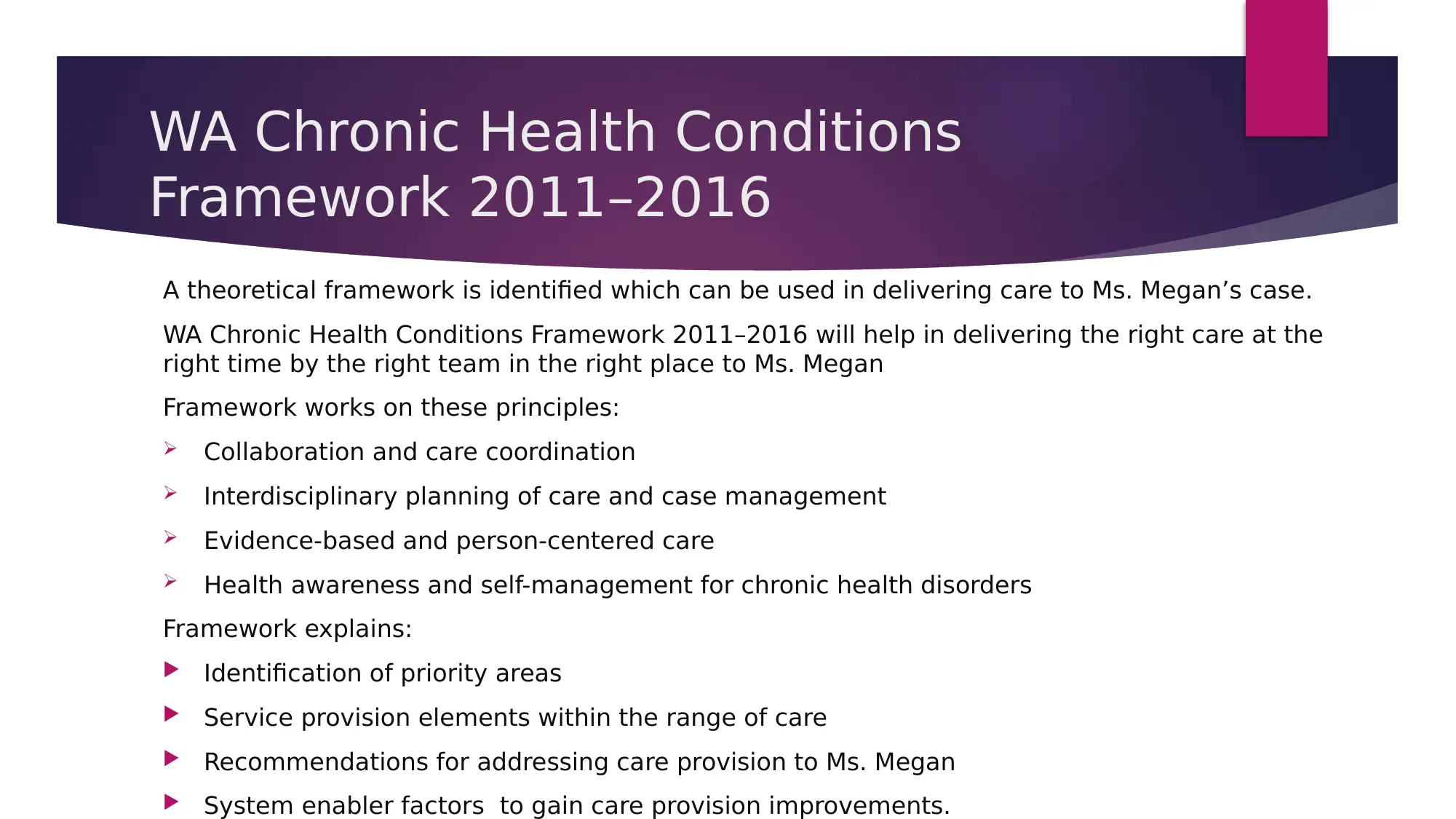
WA Chronic Health Conditions
Framework 2011–2016
A theoretical framework is identified which can be used in delivering care to Ms. Megan’s case.
WA Chronic Health Conditions Framework 2011–2016 will help in delivering the right care at the
right time by the right team in the right place to Ms. Megan
Framework works on these principles:
Collaboration and care coordination
Interdisciplinary planning of care and case management
Evidence-based and person-centered care
Health awareness and self-management for chronic health disorders
Framework explains:
Identification of priority areas
Service provision elements within the range of care
Recommendations for addressing care provision to Ms. Megan
System enabler factors to gain care provision improvements.
Framework 2011–2016
A theoretical framework is identified which can be used in delivering care to Ms. Megan’s case.
WA Chronic Health Conditions Framework 2011–2016 will help in delivering the right care at the
right time by the right team in the right place to Ms. Megan
Framework works on these principles:
Collaboration and care coordination
Interdisciplinary planning of care and case management
Evidence-based and person-centered care
Health awareness and self-management for chronic health disorders
Framework explains:
Identification of priority areas
Service provision elements within the range of care
Recommendations for addressing care provision to Ms. Megan
System enabler factors to gain care provision improvements.
⊘ This is a preview!⊘
Do you want full access?
Subscribe today to unlock all pages.

Trusted by 1+ million students worldwide

Case study analysis and
Synthesis
Synthesis
Paraphrase This Document
Need a fresh take? Get an instant paraphrase of this document with our AI Paraphraser
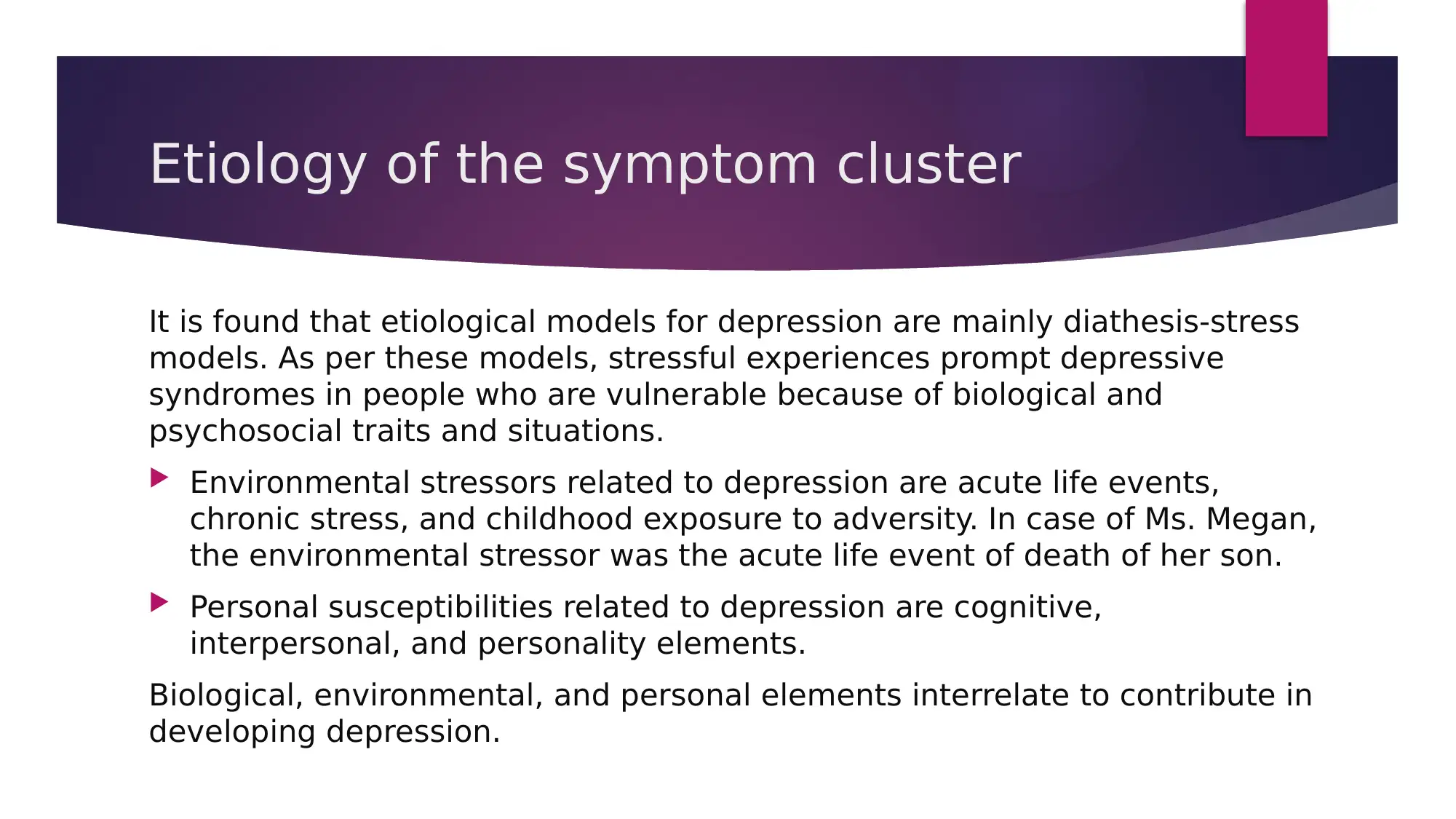
Etiology of the symptom cluster
It is found that etiological models for depression are mainly diathesis-stress
models. As per these models, stressful experiences prompt depressive
syndromes in people who are vulnerable because of biological and
psychosocial traits and situations.
Environmental stressors related to depression are acute life events,
chronic stress, and childhood exposure to adversity. In case of Ms. Megan,
the environmental stressor was the acute life event of death of her son.
Personal susceptibilities related to depression are cognitive,
interpersonal, and personality elements.
Biological, environmental, and personal elements interrelate to contribute in
developing depression.
It is found that etiological models for depression are mainly diathesis-stress
models. As per these models, stressful experiences prompt depressive
syndromes in people who are vulnerable because of biological and
psychosocial traits and situations.
Environmental stressors related to depression are acute life events,
chronic stress, and childhood exposure to adversity. In case of Ms. Megan,
the environmental stressor was the acute life event of death of her son.
Personal susceptibilities related to depression are cognitive,
interpersonal, and personality elements.
Biological, environmental, and personal elements interrelate to contribute in
developing depression.
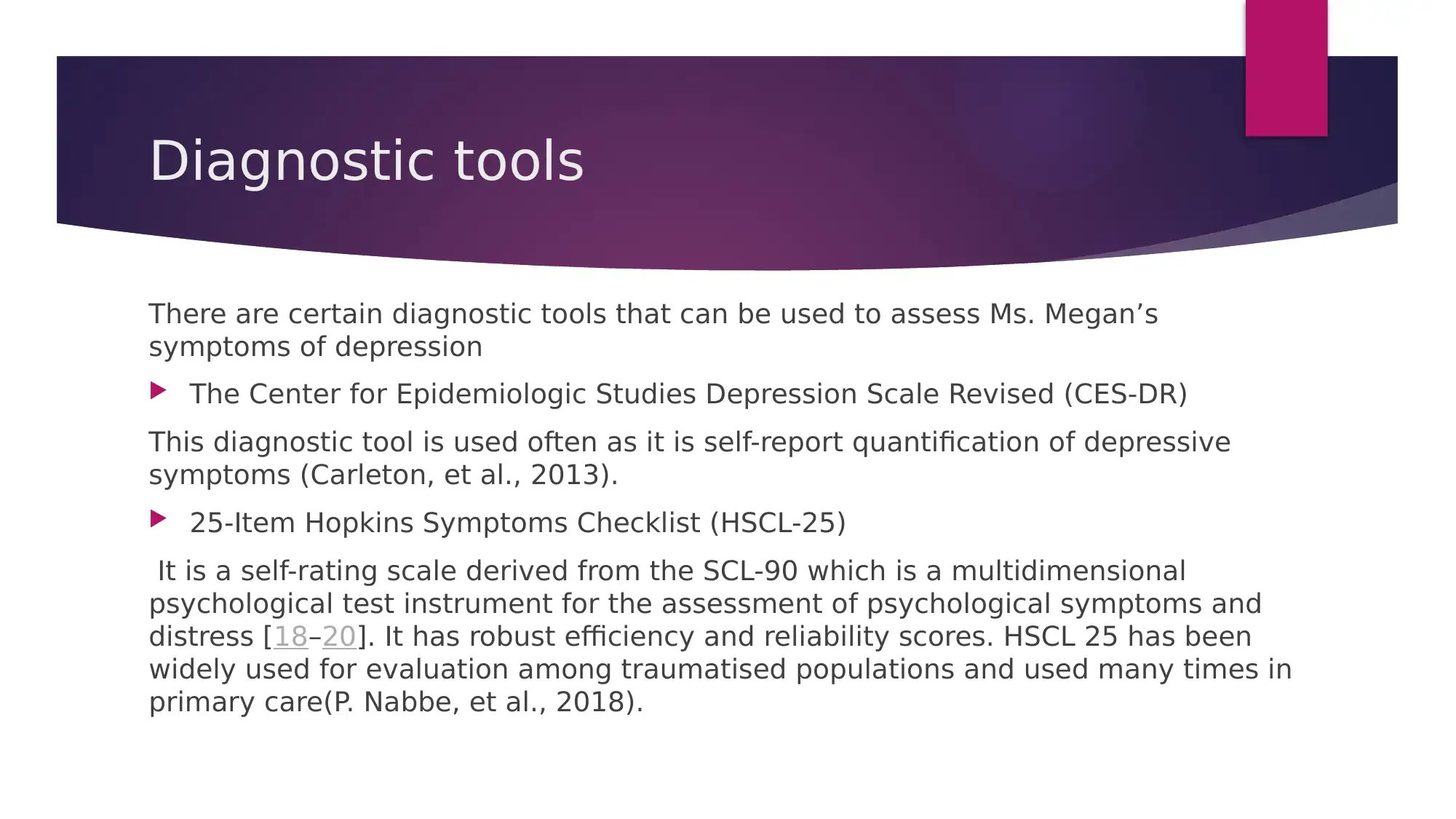
Diagnostic tools
There are certain diagnostic tools that can be used to assess Ms. Megan’s
symptoms of depression
The Center for Epidemiologic Studies Depression Scale Revised (CES-DR)
This diagnostic tool is used often as it is self-report quantification of depressive
symptoms (Carleton, et al., 2013).
25-Item Hopkins Symptoms Checklist (HSCL-25)
It is a self-rating scale derived from the SCL-90 which is a multidimensional
psychological test instrument for the assessment of psychological symptoms and
distress [18–20]. It has robust efficiency and reliability scores. HSCL 25 has been
widely used for evaluation among traumatised populations and used many times in
primary care(P. Nabbe, et al., 2018).
There are certain diagnostic tools that can be used to assess Ms. Megan’s
symptoms of depression
The Center for Epidemiologic Studies Depression Scale Revised (CES-DR)
This diagnostic tool is used often as it is self-report quantification of depressive
symptoms (Carleton, et al., 2013).
25-Item Hopkins Symptoms Checklist (HSCL-25)
It is a self-rating scale derived from the SCL-90 which is a multidimensional
psychological test instrument for the assessment of psychological symptoms and
distress [18–20]. It has robust efficiency and reliability scores. HSCL 25 has been
widely used for evaluation among traumatised populations and used many times in
primary care(P. Nabbe, et al., 2018).
⊘ This is a preview!⊘
Do you want full access?
Subscribe today to unlock all pages.

Trusted by 1+ million students worldwide
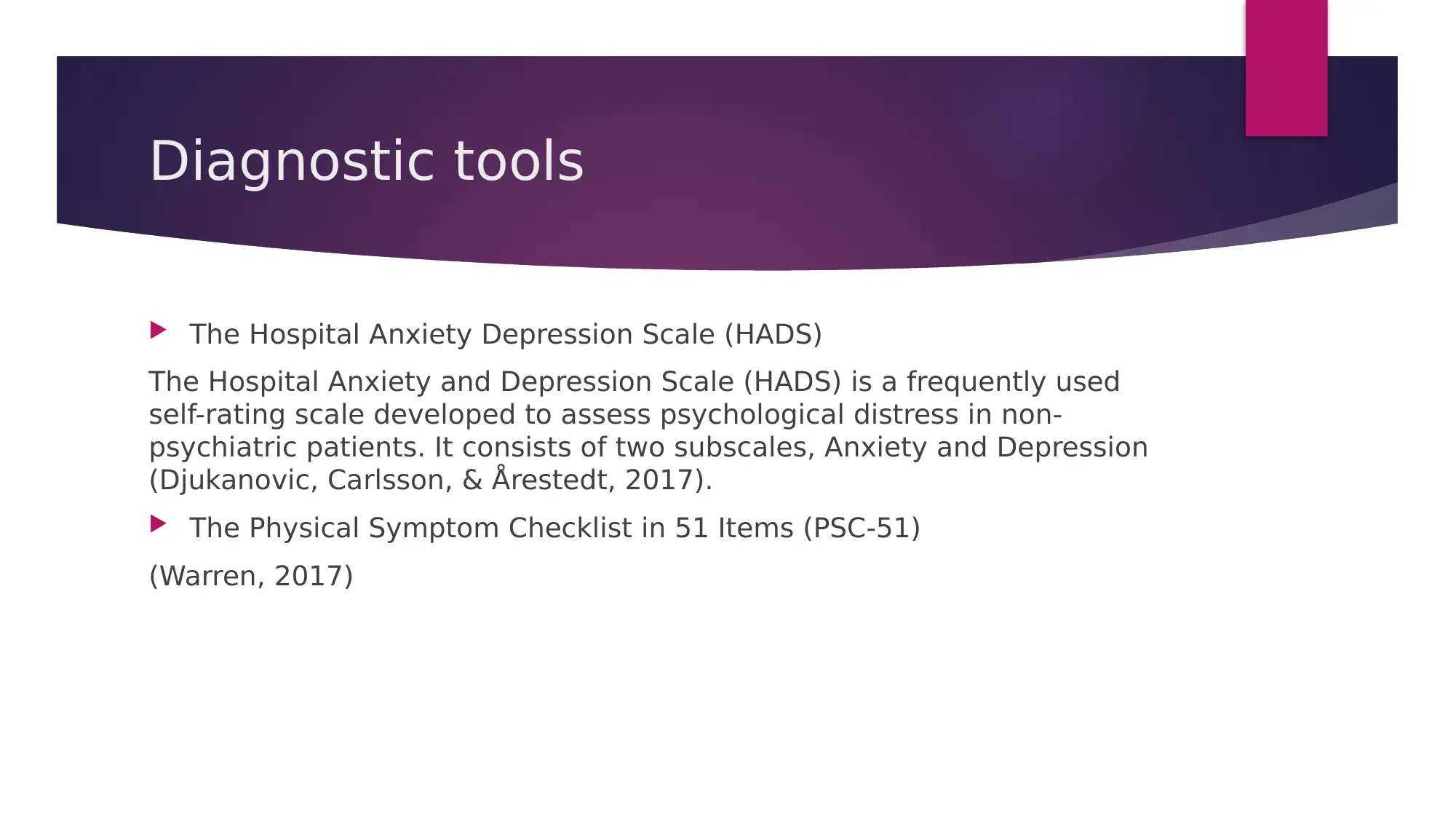
Diagnostic tools
The Hospital Anxiety Depression Scale (HADS)
The Hospital Anxiety and Depression Scale (HADS) is a frequently used
self-rating scale developed to assess psychological distress in non-
psychiatric patients. It consists of two subscales, Anxiety and Depression
(Djukanovic, Carlsson, & Årestedt, 2017).
The Physical Symptom Checklist in 51 Items (PSC-51)
(Warren, 2017)
The Hospital Anxiety Depression Scale (HADS)
The Hospital Anxiety and Depression Scale (HADS) is a frequently used
self-rating scale developed to assess psychological distress in non-
psychiatric patients. It consists of two subscales, Anxiety and Depression
(Djukanovic, Carlsson, & Årestedt, 2017).
The Physical Symptom Checklist in 51 Items (PSC-51)
(Warren, 2017)
Paraphrase This Document
Need a fresh take? Get an instant paraphrase of this document with our AI Paraphraser
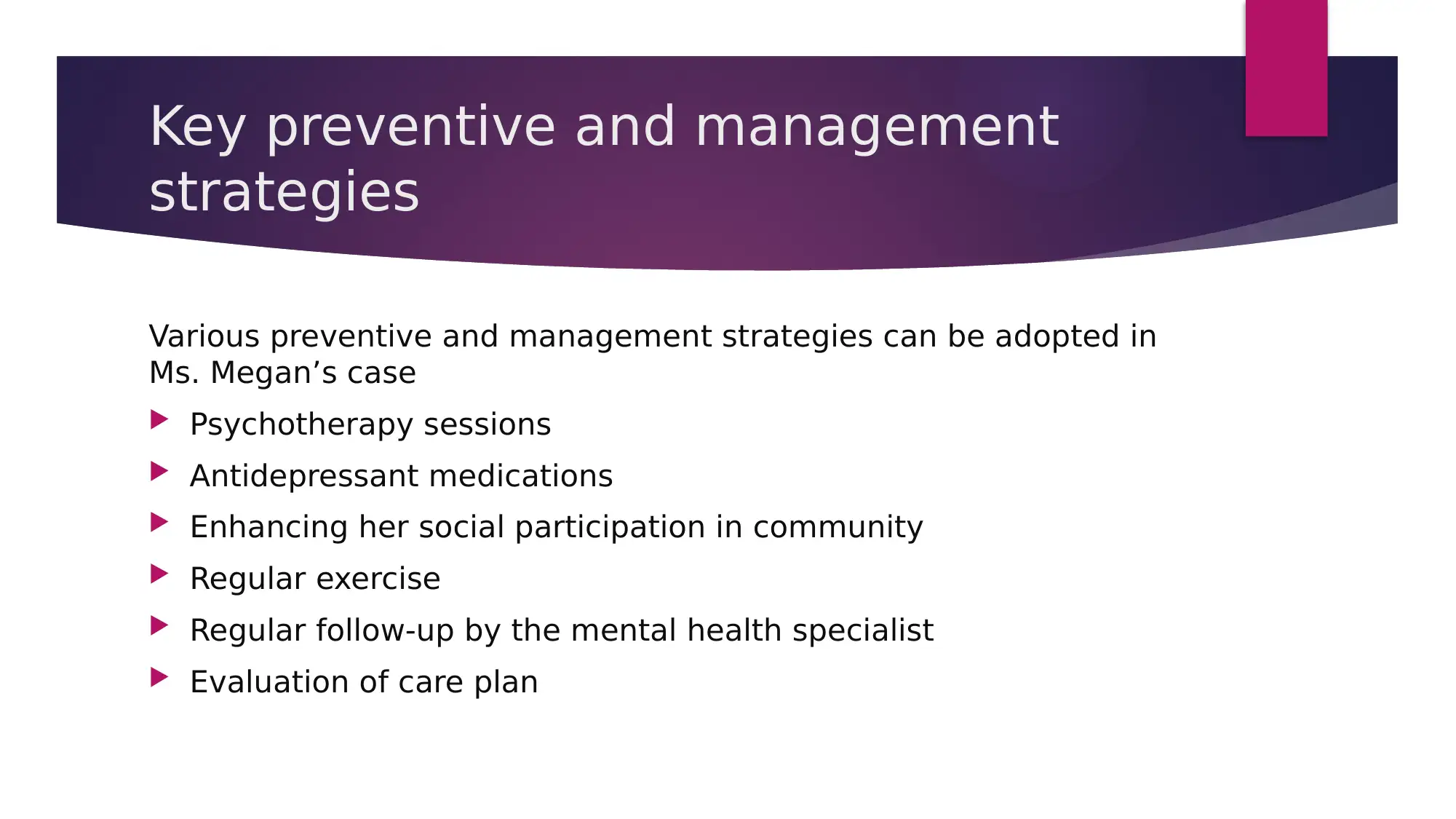
Key preventive and management
strategies
Various preventive and management strategies can be adopted in
Ms. Megan’s case
Psychotherapy sessions
Antidepressant medications
Enhancing her social participation in community
Regular exercise
Regular follow-up by the mental health specialist
Evaluation of care plan
strategies
Various preventive and management strategies can be adopted in
Ms. Megan’s case
Psychotherapy sessions
Antidepressant medications
Enhancing her social participation in community
Regular exercise
Regular follow-up by the mental health specialist
Evaluation of care plan
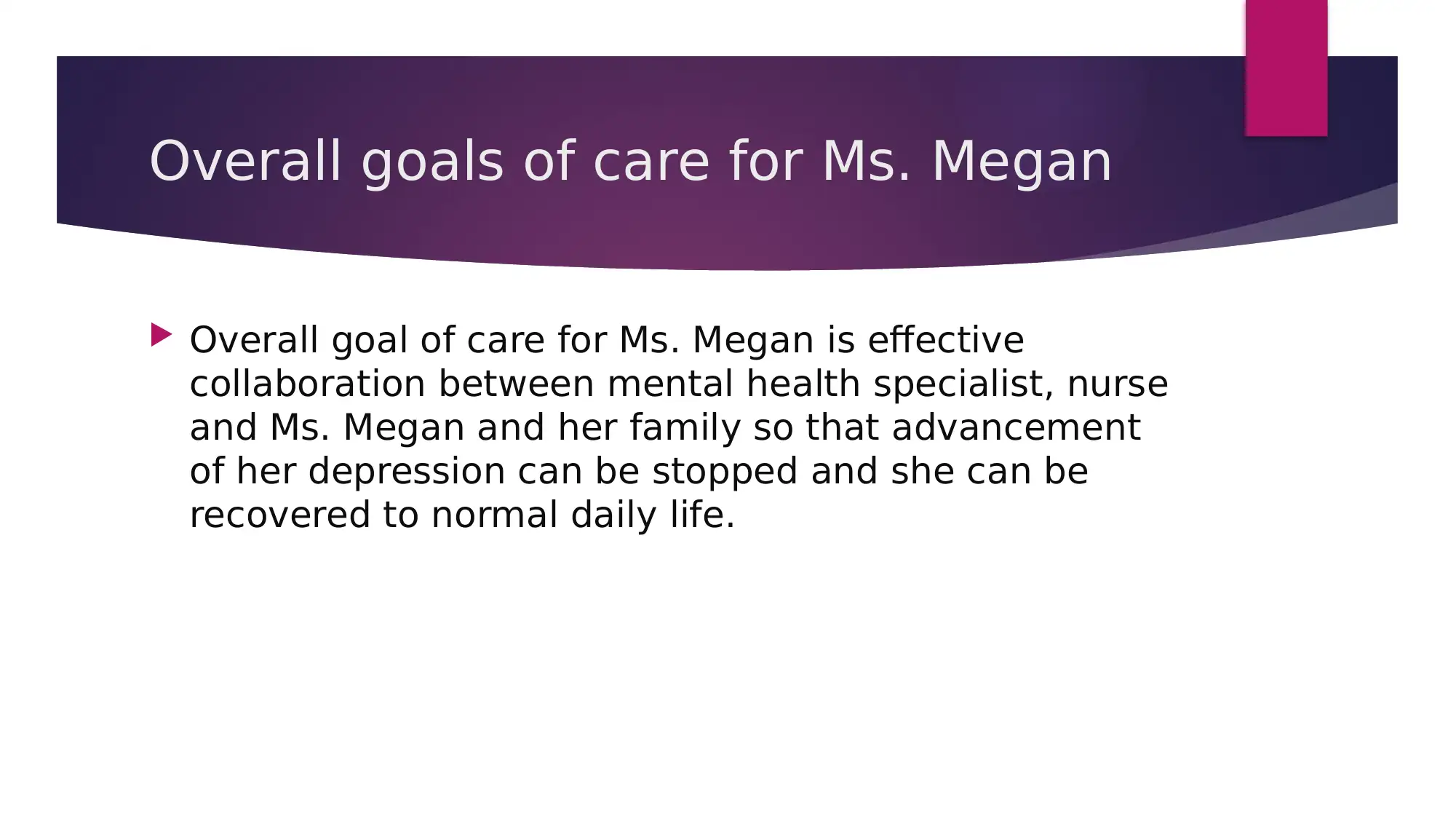
Overall goals of care for Ms. Megan
Overall goal of care for Ms. Megan is effective
collaboration between mental health specialist, nurse
and Ms. Megan and her family so that advancement
of her depression can be stopped and she can be
recovered to normal daily life.
Overall goal of care for Ms. Megan is effective
collaboration between mental health specialist, nurse
and Ms. Megan and her family so that advancement
of her depression can be stopped and she can be
recovered to normal daily life.
⊘ This is a preview!⊘
Do you want full access?
Subscribe today to unlock all pages.

Trusted by 1+ million students worldwide
1 out of 17
Related Documents
Your All-in-One AI-Powered Toolkit for Academic Success.
+13062052269
info@desklib.com
Available 24*7 on WhatsApp / Email
![[object Object]](/_next/static/media/star-bottom.7253800d.svg)
Unlock your academic potential
Copyright © 2020–2025 A2Z Services. All Rights Reserved. Developed and managed by ZUCOL.




